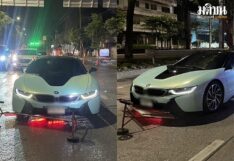Note: Mr.Chod Reankittiwat, CFA Economist Office of The National Broadcasting and Telecommunications commission (NBTC) wrote this article which predicts what will happen to businesses such as hospitals and taxis after 5G has been deployed.
I believe that readers are aware as to what 5G technology offers at the beginning. Today we will discuss the potential of 5G usage and how it will change daily lives and businesses and will have an impact and how we should adjust to this or find opportunities to use it in work and business operations in the future.
The essence of 5G technology is to improve the stability and the speed of mobile Internet traffic which will be around 30-100 times better than existing 4G traffic.
The faster Internet will not only enable more rapid downloads of movies or videos on YouTube and the changes that 5G will bring will have profound effects on many sectors of the economy in the future.
Thailand has long been known for its provision of healthcare services to foreigners and it is one of the world’s medical tourism hubs although it still faces a shortage of doctors in remote areas up until today.
Even the Government and the National Broadcasting and Telecommunications Commission (NBTC) have already created an Internet village to empower tele-medicine in rural areas but at present this still provides only basic diagnoses that rely on patients and doctors communicating with each other through images and voice. The treatment of complex diseases or complicated surgery still cannot be done.
But, in the future when 5G technology arrives, tele-medicine will not be limited to just diagnosis. 5G will create a “tactile Internet” or an Internet of touch that will send data in addition to pictures and audio to include interactive touch sensations.
Imagine, this would be like a joystick in a Playstation that would have various forms of vibration when a character in a game faces different incidents.
This vibration of the joystick together with images will translate into a tactile system to connect to a robot over the Internet using 5G so that it will be possible to use a robot to perform treatment such as tele-surgery controlled by a doctor sitting in a hospital in Bangkok over the Internet.
In addition to expanding healthcare service coverage to rural areas, 5G technology also opens the opportunity for leading hospitals in the city to expand their businesses overseas.
If, for example, a leading Thai private hospital which has a weakness when it comes to branch expansion, and which may have only one branch in the Sukhumvit area in the city center, would be capable of leveraging the world recognition in Thai healthcare branding which could make its revenue growth become exponential.
With the arrival of 5G technology, this hospital would no longer need to expand its branches but only to build telemedicine resources for domestic and overseas use by deploying talented doctors to work in Bangkok to provide diagnosis and treatment through the tactile Internet. This will help maximize the potential of Thailand’s leading brands.
Another application that is expected when the world enters the 5G era will be the Intelligent Transport System (ITS) that covers autonomous driving (self-driving vehicles). This will be the application of IoT or the Internet of Things to connect communications from various devices such as road sensors and cars in order to maximize the efficiency of national mass transit systems such as to improve bus routes or the frequency of trains.
When the technology is fully developed, it will be possible to dream of using intelligent, driverless vehicles that rely on the Internet to connect effectively and reliably thanks to 5G. Of course, if this can be applied, Bangkok traffic will flow more smoothly since today the manners of car drivers are still a problem and they would be replaced by robots to control the vehicles.
In terms of a business model, a clear example of stable leadership comes from overseas in the form of the vision of the Japanese billionaire with Korean blood Masayoshi Son who is the director of the leading Japanese mobile operator Soft Bank which has a long history of investing in start-up technology, including being the major shareholder and the first which dared to invest in Alibaba, helping it to become the the largest technology company in Asia today.
At present, Masayoshi has a start-up find called the Vision Fund which is the world’s largest venture capital fund with nearly 100,000 million US dollars or 3 trillion baht under its management. Over the past few years, Masayoshi has invested in taxi service mobile apps, both Uber in the US and DiDi in China, along with Grab in Asean, using at least 20,000 million US dollars or 600,000 million baht.
The reason why Masayoshi made such a big investment in these companies is because he believes that in the future, when the artificial intelligence (AI) technology of these affiliated companies is developed and is combined with improvements in the mobile Internet with sensors on the road and in vehicles with the data connected through high speed Internet and with the reliability of 5G with city-wide coverage, or maybe worldwide coverage with the help of satellite signals based on his vision, he can create a real-time system comprised of autonomous vehicles. This would be a fully integrated intelligent transportation system that could be connected in the blink of an eye.
The trend could be that the careers of taxi drivers, car rental services and even the buying and selling of cars could become extinct. When we can call an autonomous car at any time through a mobile application there would be no need to drive or to purchase a car any more.
And the final point which has to be mentioned is the use of 5G in augmented reality (AR) and in virtual reality (VR) or the effective creation of a real virtual world.
These two are not exactly the same. AR is augmented reality – adding something new to the real world. The most famous example is Pokemon Go which is a mobile game that makes us see virtual characters in real-world environments through the camera of a mobile phone. Meanwhile VR is creating a whole new virtual world without reference to any existing environment. Of course, both will revolutionize the game industry and media in the future as players and viewers will experience more realistic experiences through VR and AR.
In addition, AR and VR may change the retail sector. According to a UBS bank survey of more than 5,000 consumers in Asean, e-commerce is currently one of the most widespread forms of commerce in the region, but it is still limited to products that one doesn’t need to touch or to see a real sample, such as general clothing or cosmetics.
Selecting to buy fresh food or jewelry or branded products such as luxury clothing still requires a direct buyer experience in a store to choose the product, but when VR and AR comes we may build a virtual world for trying out and buying goods as real products become visible through the Internet at home with no need to come to a store – providing a big boost to e-commerce in the future.
Another example is Ule.com, an e-commerce service which is one of China’s rising stars, being a joint venture between China Post and Hong Kong billionaire Le Ka-Shing who set up a grocery store subscription system throughout Zhejiang. In order to use these e-commerce services, people in remote areas can shop with their mobile phones for items that will be delivered to local grocery shops the next day. Customers can then pay to pick up the products at grocery stores and Ule’s vision is to build a virtual WalMart or virtual reality store everywhere through a network of grocery stores or convenience stores.
The parent company does not have to invest to expand its branches to remote areas since if AR or VR technology is available over 5G for use it may be able to create a realistic experience for online shopping. This would do away with the need to have shopping outlets in villages while villagers will benefit by ordering online just as though they were in a physical store and then receiving the products the next day. The application of this concept could cause 5G to be the turning point for retail sales in the future.
Hence we will see that in the future, 5G, which is a high-speed mobile Internet, will bring us a touch-based Internet, the Internet of things and virtual reality – which 4G cannot do.
Definitely, the impact on healthcare, transportation and the retail industry, as mentioned, is still a vision that has not happened yet, but it can be considered an opportunity and a possibility, or a vision of international leaders.
However, this does not mean that the world in the future will always turn out to be as is expected. Hopefully, this article will allow readers to figure out how the world in the future of the 5G era will be and how they should prepare for the changes or explore opportunities to become familiar with this new technology in order that they do not “miss the boat”.










